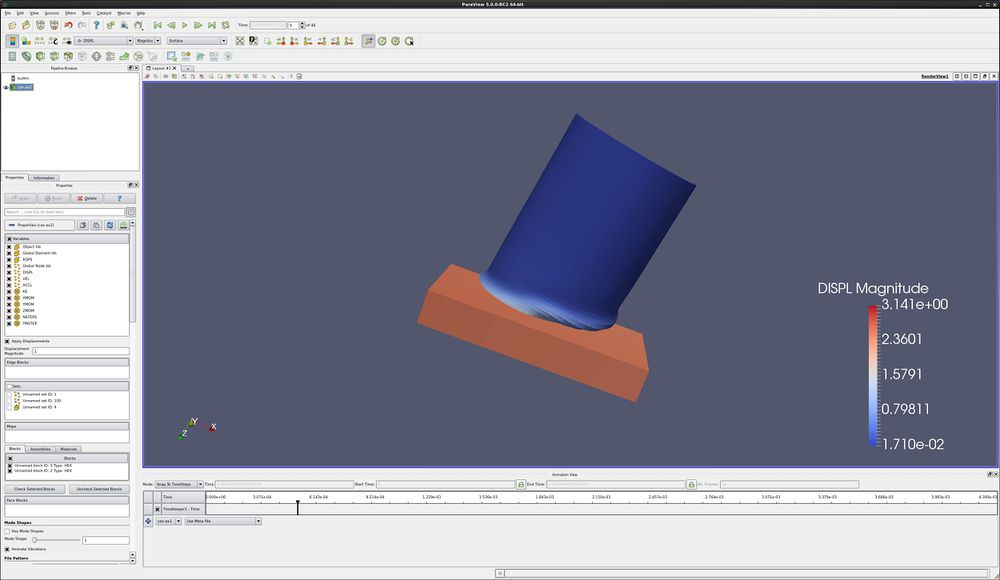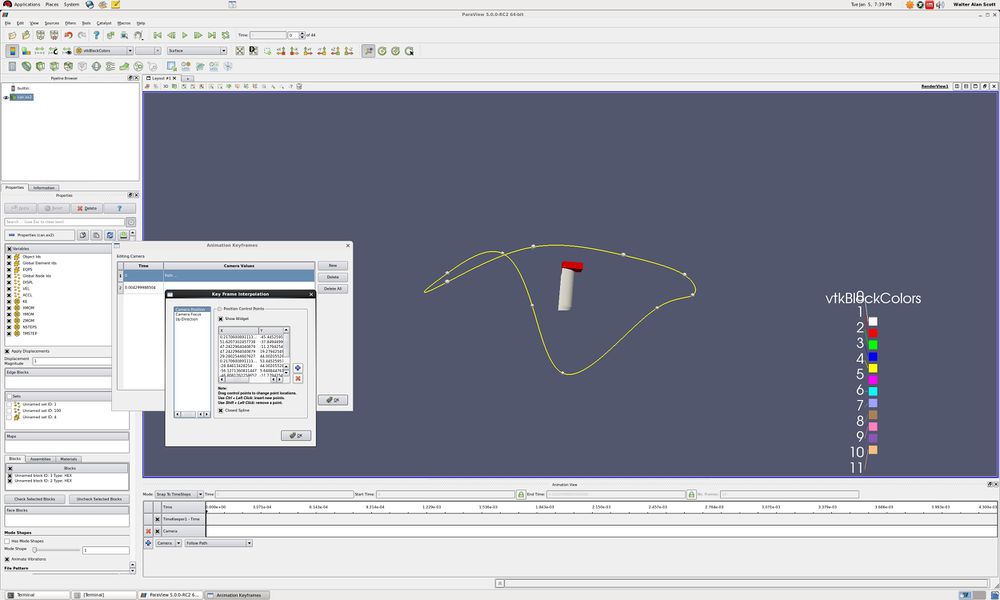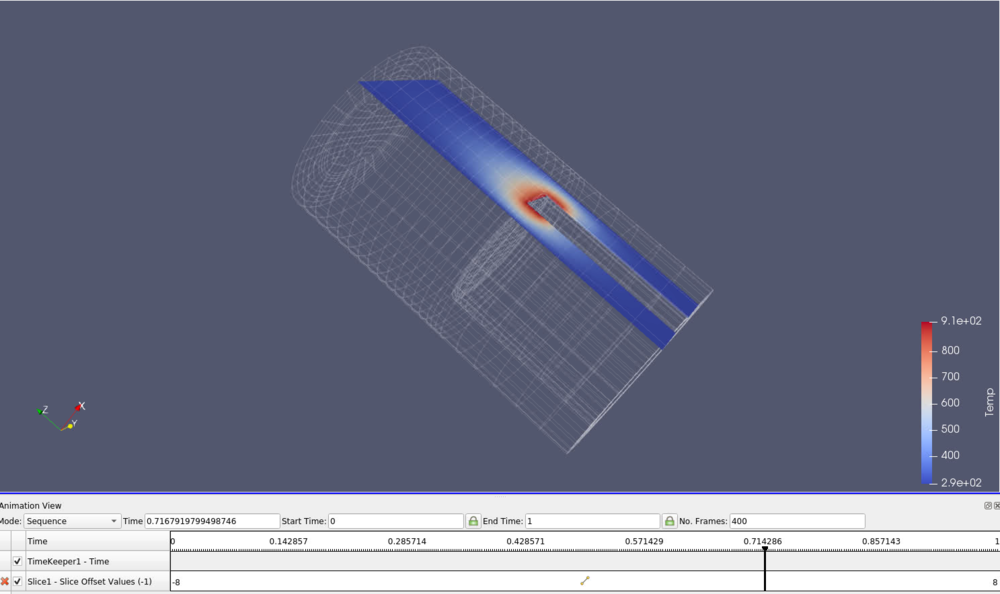Advanced Animations
Introduction
This tutorial deals with advanced topics in animations.
The Animation View
- Open the data set can.exo, which can be downloaded at http://www.paraview.org/paraview/resources/software.html
- On the Properties tab, select all variables and press the Apply button
- Drag the can around with the left mouse button
- Move forward to timestep number 5
- Color by DISPL
- (If you changed the order of the steps above, you may need to click "Rescale to Data Range"
- View → Animation View
- Grab the slider bar and move it back and forth.
Real Time
- In the Animation View window, change the mode to Real Time, and the Duration to 100.
- Play. Notice that the can motion is now very slow. We are saying that we want the whole animation to last 100 seconds.
- Note - this can also be used to speed up datasets with a large number of time steps. Set the Duration to 10, and ParaView will animate over all time in 10 seconds. Obviously, this is dependent on the whether ParaView can keep up with this frame rate!
Temporal Interpolator
- In the Animation View window, change the mode to Sequence, and the No. Frames to 200.
- Filters → Temporal → Temporal Interpolator.
- Play. Notice that the can motion is now smooth. ParaView is interpolating between frames, and making 200 time steps.
- Note that this only works with data that stays consistent through the whole time sequence. AMR (Adaptive Mesh Refinement) data does not work with the Temporal Interpolator.
Move the camera
There are four ways to move the camera. they are:
- Orbit
- Follow Data
- Interpolate Camera Locations
- Follow Path
Orbit Camera
We are going to make the camera rotate around our data.
- Edit → Reset Session
- Open the data set can.exo.
- Apply.
- +Y
- View → Animation View
- Add a camera. Default motion is Orbit, so click the blue +.
- A Create Orbit dialog will appear. Take the defaults, hit OK.
- Play.
Camera Follow Data
We are going to make the camera follow the data.
- Edit → Reset Session
- Open the data set can.exo.
- Apply.
- +Y
- View → Animation View
- Add a camera. Change Orbit to Follow Data. Click the blue +.
- Play.
Note that the follow data option will follow the data from whatever filter is highlighted. This means that you can choose one cell, run the Extract Selection filter, and follow this cell. Note that you must keep visibility on for this cell. If needed, you can turn the cell's Opacity (Properties tab) to 1%, making it disappear. By turning visibility on for your whole dataset, you can follow the cell but display all of your data.
Interpolate Camera Position
We are going to move the camera along a straight line. We want to move the camera to follow the can.
- Edit → Reset Session
- Open the data set can.exo.
- Apply.
- +Y
- View → Animation View
- Add a camera. Change Orbit to Interpolate Camera Position. Click the blue +.
- Left click on the white section of the camera row that just appeared.
- An Animation Keyframes dialog will open.
- Left click the top Position.
- Use Current. OK
- Play to the last timestep. Move the can dataset back into the center of the screen. Tip - Don't hit Reset.
- Left click the bottom Position.
- Use Current. OK.
- OK
- Play.
You can also create an intermediate destination for the can by going to the Animation Keyframes dialog, and selecting New. Then, follow the directions above.
Experiment by adding more keyframes and different camera angles.
One way to create tracks in 3d space is to use Interpolate Camera Location, and place the control points onto a plane. Then, copy these control points, and then copy them into the 3d simulation you want to animate.
Follow Path
We are going to move the camera along a spline. Advanced operation.
- Edit → Reset Session
- Open the data set can.exo.
- Apply.
- +Y
- View → Animation View
- Add a camera. Change Orbit to Follow Path. Click the blue +.
- Left click on the white section of the camera row that just appeared.
- An Animation Keyframes dialog will open.
- Left click on Path.
- Click on Camera Position.
- Now, in the 3d view, zoom out. Rotate the can. You will see a yellow circle with white spheres. Drag the spheres around.
- OK.
- OK.
- Play.
One way to create tracks in 3d space is to use Interpolate Camera Location, and place the control points onto a plane. Then, copy these control points, and then copy them into the 3d simulation you want to animate.
Animating a Filter
In the previous example we showed how to manipulate the camera using the Animation View tools. In this example we will show how to animate a filter. Our goal is to move a slice through our dataset over time.
- Lets start from scratch. One way is to go Edit/ Reset Session. Ok.
- If you closed it, bring up the Animation View.
- Open disk_out_ref.exo, all variables on, Apply.
- Slice filter. Apply. Turn off the Show Plane.
- In the Animation View, change Mode to Sequence, and number of frames to 400.
- We want to create a track that is Slice, Slice Offset Values. Click the blue +.
- Double click on the track. This will bring up a dialog, and will set the start and end.
- Change the starting value to -8 and the ending value to 8.
- Play.
Data Animation
In this example we will show how to animate your data set. Our goal is to show one data set, then fade into another dataset. This can be handy when one physics simulation runs for an early time period, and another physics simulation runs for the later time period.
- Lets start from scratch. One way is to go File/ Disconnect. Ok.
- If you closed it, bring up the Animation View.
- Open can.exo, all variables on, Apply.
- Open can.exo again, all variables on, Apply.
- Select the upper can.exo, and change to color by DISPL. Last time step, Rescale to Data Range, first time step.
- Select the lower can.exo, and chage the representation to Wireframe.
We now want to fade from the first version of the can to the second version of the can. This is done as follows:
- On the Animation View, on the can.ex2 pulldown menu, select the upper can.ex2. Right of there, use the pulldown menu to select Opacity. Click the blue plus sign.
- Do the same for the lower can.ex2.
- Click on the upper can.ex2 white horizontal bar. Double click on the upper value, change it to 1. Double click the lower value, change it to 0. OK.
- Play.
You can substitute Visibility for Opacity when you add tracks to the Animation View. Then, on one dataset, you can run visibility of 1 for half of your time, and run visibility of 1 for the other dataset for the second half of your time. Thus, you will show the first simulation for the first half of your animation, and the second simulation for the second half.
Warp Vector Filter
- If your dataset has displacement data, but it is not using a variable name that ParaView recognizes, you can still animate your data. Choose the Filters/ Alphabetical/ Warp Vector filter.
Acknowledgements
Sandia National Laboratories is a multi-mission laboratory managed and operated by National Technology and Engineering Solutions of Sandia, LLC., a wholly owned subsidiary of Honeywell International, Inc., for the U.S. Department of Energy’s National Nuclear Security Administration under contract DE-NA-0003525.


